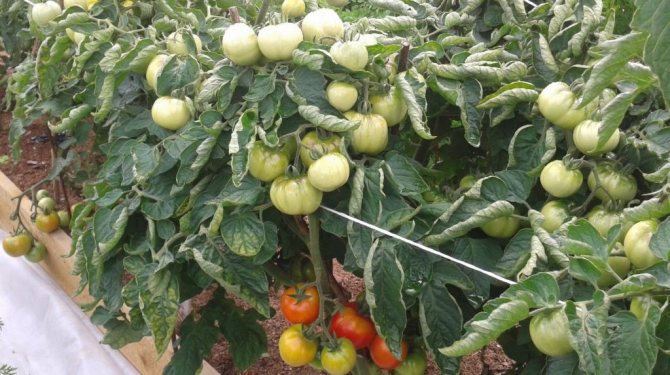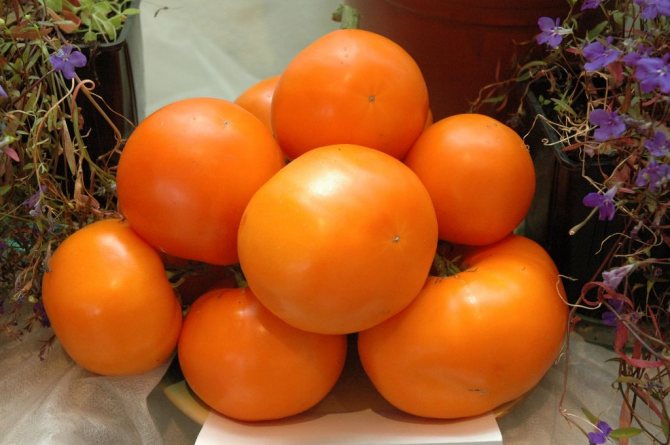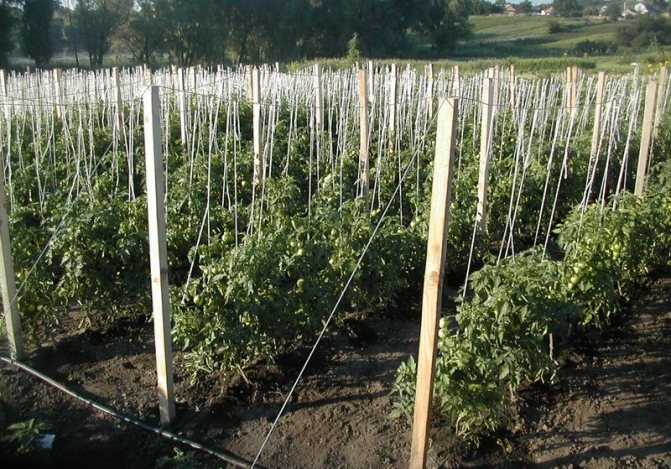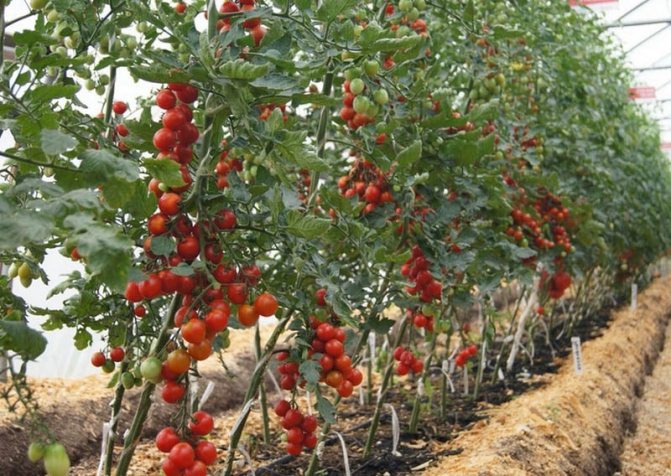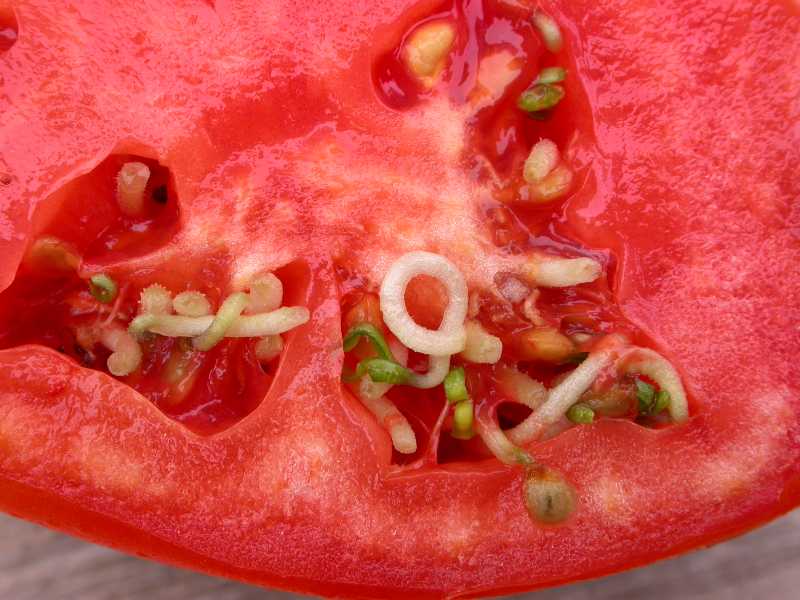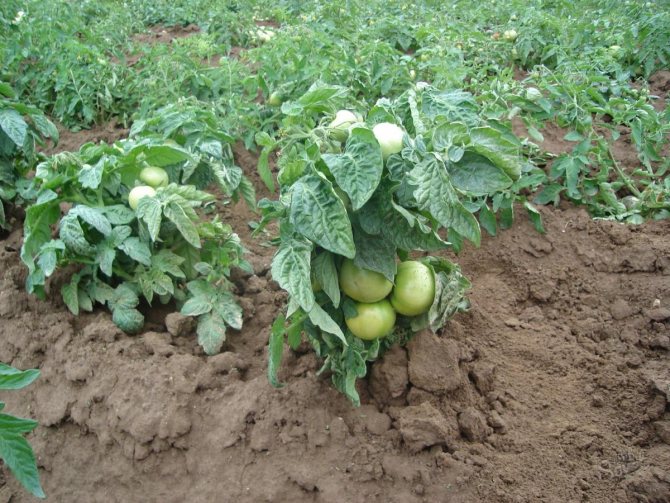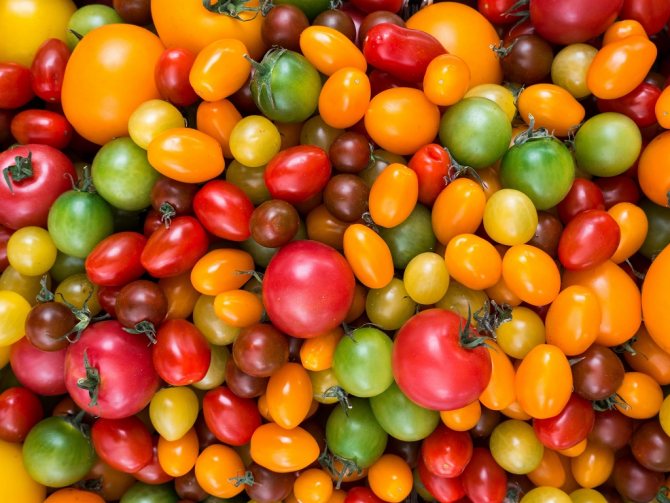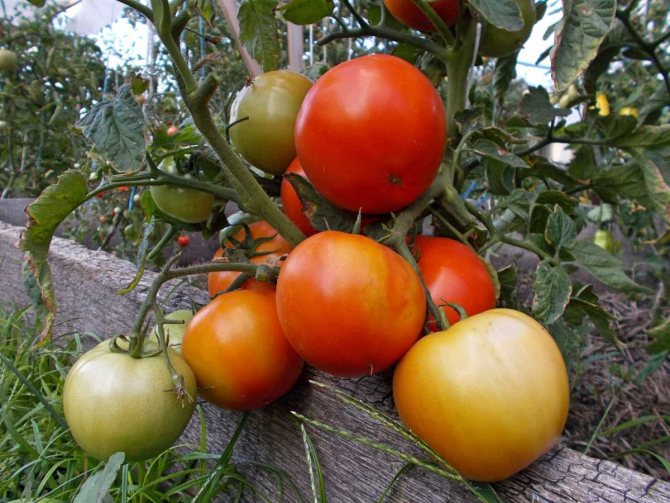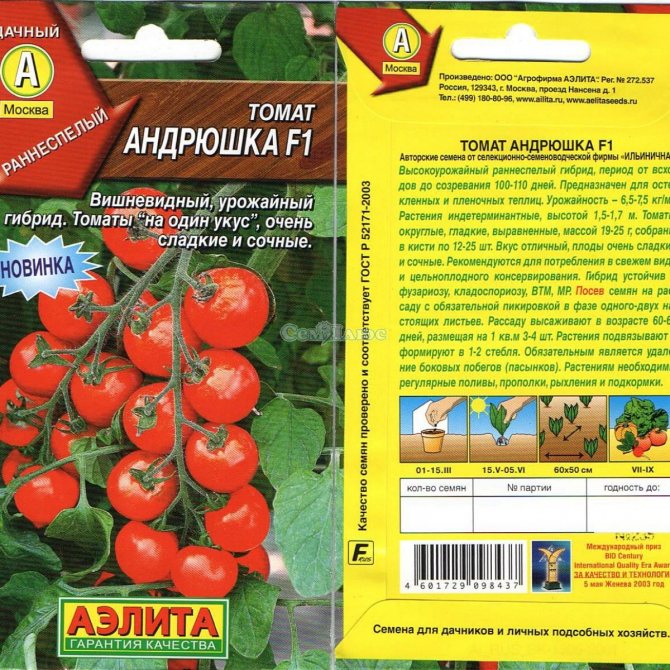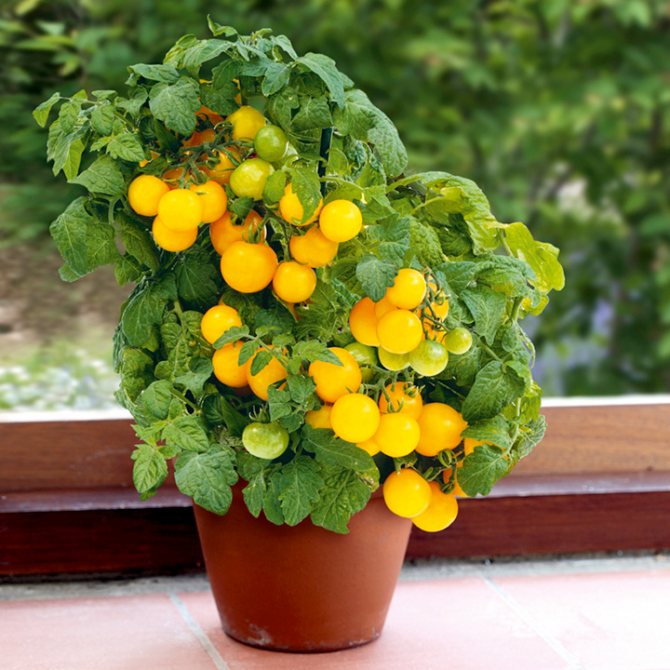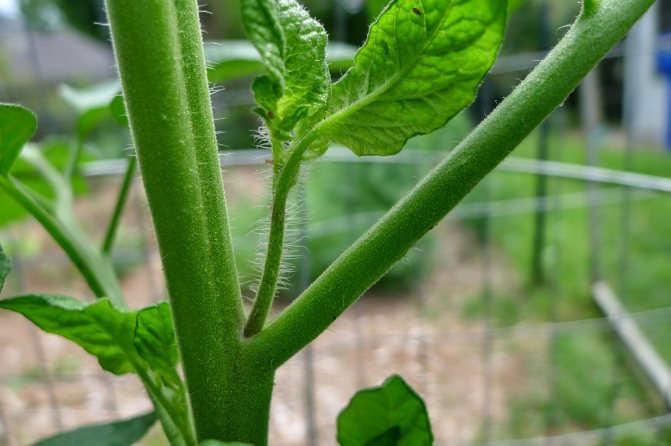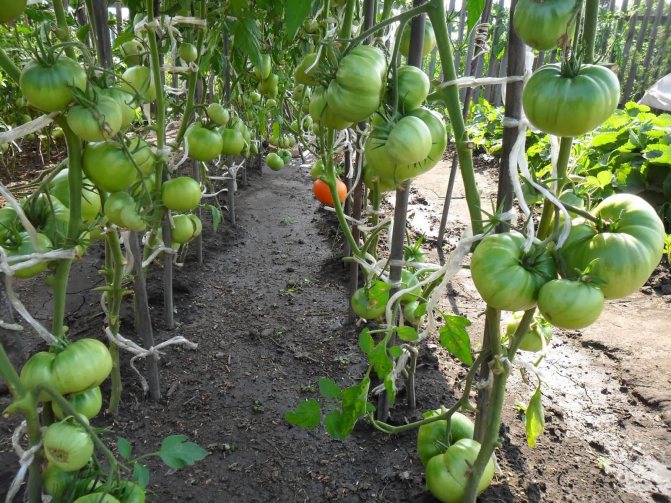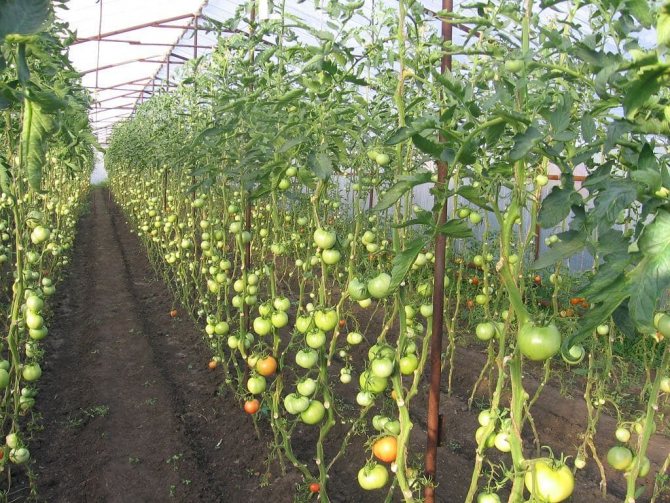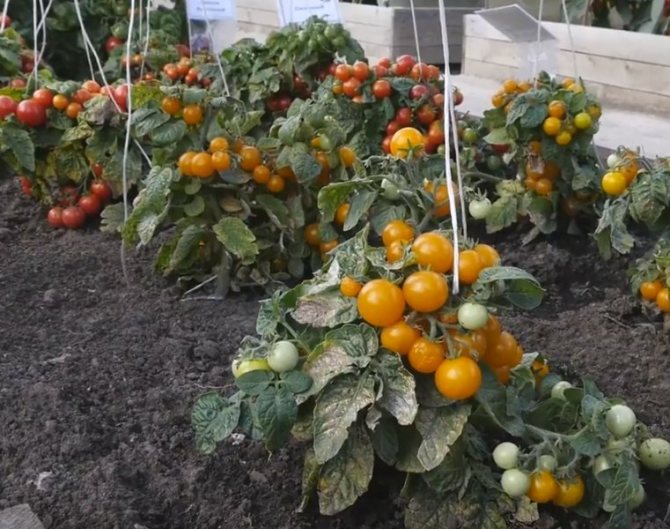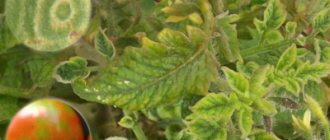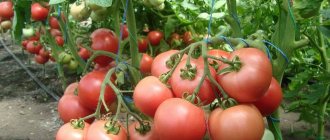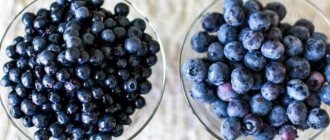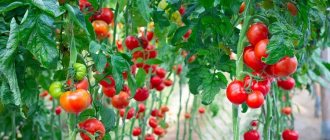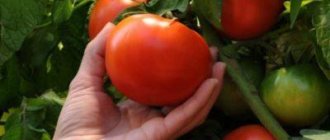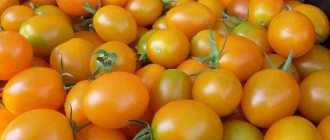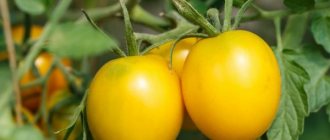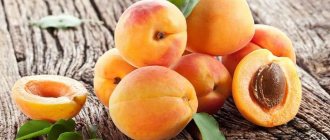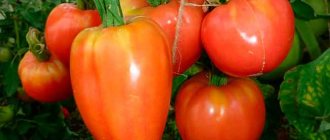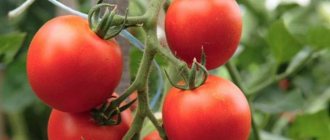Author rating
The author of the article
Yakov Pavlovich
Professor, Head of the Department of Vegetable Growing
Articles written
153
When purchasing bags with vegetable seeds, in addition to the familiar information, you can also see such a designation on them - a determinant variety. What does this mean for tomatoes and other vegetables? Determination characterizes the height of a plant and means that its growth is limited. This also determines the methods of caring for him, the place of planting, and the yield. There are indeterminate tomatoes that need to be restricted.
The main differences between varieties
A description of the difference between these types of tomatoes will help you choose the variety that best suits your needs and expectations from the many varieties.
What does "determinant" and "indeterminate" mean?
All plants that have limitations in their growth are categorized as determinant. In contrast, tall ones are called indeterminate.
Determinant tomatoes are varieties of tomatoes that grow up to a maximum of 70 cm and stop growing with the formation of a fruit ovary at the end of the main shoot. Further development occurs on lateral shoots (stepchildren).
What are indeterminate tomatoes? The fruits of these crops are placed on a central stem, which reaches 2-4 m in height.
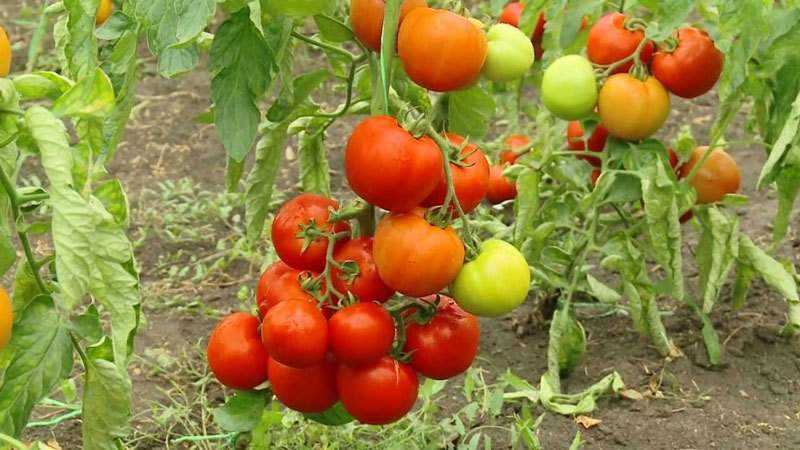
We distinguish varieties at all stages of growth
The question is relevant if the seeds or seedlings are presented to you by a friendly owner of a neighboring summer cottage and you do not know exactly which category the plants belong to.
Seeds
At the stage of choosing seeds, you will have to trust the manufacturer: the package contains the characteristics of the variety. Gardeners prefer hybrid varieties. Breeding hybrids specifically provides for a set of certain qualities. Therefore, unlike pure varieties, they are the most resistant to common diseases and adapted to growing in certain climatic conditions.
Seedlings
By the first sprouts, you can already determine which variety they belong to. The height of the stem from the root to the cotyledon of a determinant tomato is 1-2 cm, of an indeterminate one - up to 5 cm.
Mature bushes
Stem length is not the main difference between an adult plant. There are high determinant varieties intended for cultivation in greenhouses. And indeterminate standard ones, on the contrary, are characterized by short stature.
The shape of the tomato bush will become a sure sign that determines belonging to the categories of interest to us. The formed brush at the top of the shoot and the formation of several inflorescences simultaneously indicate the determinant type of tomato. In indeterminate cultures, the ovaries are grouped around the central stem along its entire length.
Determinancy
Inexperienced gardeners, reading the description of the variety, are at a loss to guess what this word stated in the description means.
What does determinant tomatoes mean?
How is this expressed? Growth restriction occurs by the appearance of a flower brush, on which flowers will first appear, and then the fruits will be tied. Further growth will occur from a strong stepson, which will emerge from the axil of the leaf located just below the brush at the top of the bush.
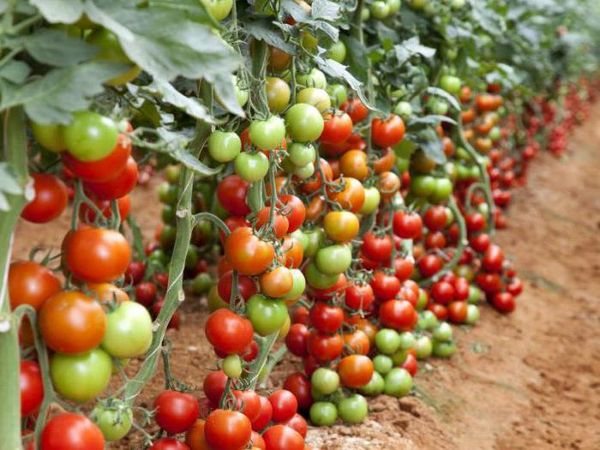

Determinant tomato variety
Determinant tomatoes are also subdivided into:
- Semi-determinant - includes varieties and hybrids with an intermediate type of branching;
- Superdeterminant - this includes a group of early ripening varieties;
- Super super determinant - this includes super early maturing varieties with dwarf growth.
Indeterminate tomato
it tall tomatoes, which should be mechanically restricted in growth. Since such a tomato vine grows up to 4 m in height. But since the warm season is short in our country and the tomatoes above 2 m will not have time to ripen, the top is removed at this height.
Stamp
These are industrial varieties of tomatoes that are grown on large areas for further sale or processing of tomatoes. They do not require a garter, have a thick stem and receive the first fruits on day 75 after the first shoots of seedlings.
Tomatoes of this type begin to ripen already at the end of June.
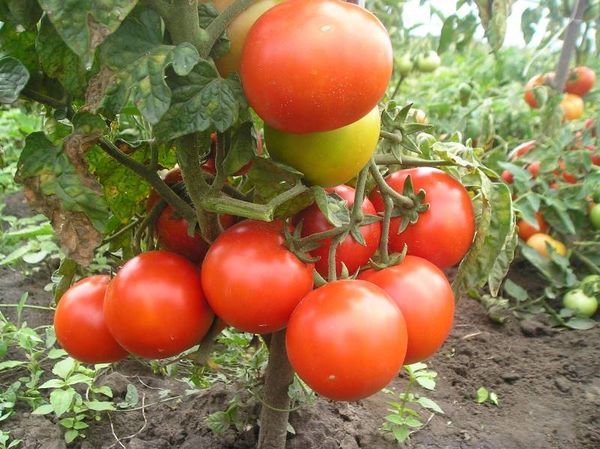

Standard varieties are used for industrial cultivation, they are unpretentious
Semi-determinant
A tomato bush that does not stop at the meter height and continues to grow. But growth can stop at any moment. Grow it in two stems, and is suitable for greenhouse conditions.
Growing features
These characteristics are so important that they largely determine the fate of your future harvest.
Location in a greenhouse or garden bed
It is advisable to grow indeterminate varieties of tomatoes in a high greenhouse (up to 2 m). With a long fruiting period, they produce crops for most of the year.
Important! Regular airing of the greenhouse will create optimal conditions for pollination and protect tomatoes from barren flowers.
Determinate and short-growing standard varieties of indeterminate tomatoes are more suitable for growing in the open field.
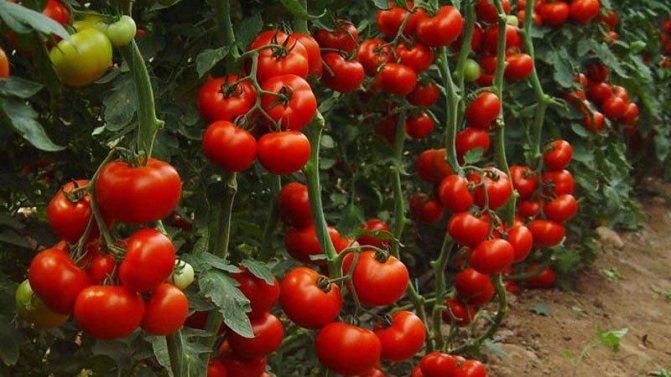

Seedling care
An error in the timing of planting and placement of seedlings on the site, ignorance of the rules for caring for them can minimize the result of your efforts.
Sowing dates
Planting tomatoes in the ground or greenhouse is preceded by the cultivation of seedlings. Seeds of indeterminate varieties are sown in early March. After 65-75 days, the seedlings are ready to move to the garden bed.
Determinant varieties are sown at the end of March. The seedlings ripen for 55-60 days.
Important! The optimum soil temperature for planting tomatoes is not lower than 15 ° C.
Stepping
In caring for tomatoes, it is important to promptly remove non-fruiting branches (stepchildren) from the bush, located between the base of the leaf and the main stem. This agronomic technique (pinching) is aimed at eliminating the irrational distribution of nutrients by the plant. The correct formation of the bush increases the yield.
Indeterminate varieties need pinching to a much greater extent than their undersized counterparts. Extra shoots are removed every decade throughout the growing season. The stepchildren gently break off, leaving a stump 1-2 cm high. Further, the bush is formed in one of the ways: only the central stem with fruit clusters is left, or the most developed stepson is chosen as the main one.
Important! Having chosen the stepson as the main shoot, after the formation of fruit ovaries on it, pinch the former main stem (pruning is not recommended). This will stop its further growth.
Determinant tomatoes are not prone to uncontrolled growth of green mass. For them, pinching is greatly simplified. Since the first three inflorescences bring the main crop, the process is aimed at accelerating their ripening. It is enough to remove all stepchildren below the branch on which the ovaries have formed. The bottom two stepsons should be left, otherwise the plant will stop developing and stop fruiting.This type of bush formation is called "three-stem" and is recommended for determinate varieties.
Important! The efficiency of the process will increase if you do not allow the growth of the stepsons to be removed more than 7 cm.
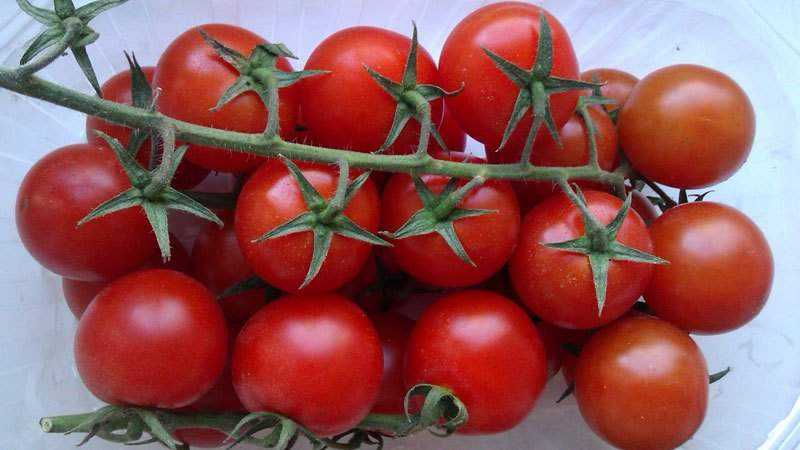

Indeterminate tomato varieties
There are many varieties and hybrids of indeterminate tomatoes. Some of them have already been tested by time and several generations of gardeners. Breeding novelties are constantly available in the public domain. All of them have certain advantages, but they are not devoid of disadvantages. Accordingly, you need to familiarize yourself with the description in advance so that there are no surprises during cultivation.
Indoor
In greenhouses, indeterminate tomatoes are most often cultivated in central Russia, as well as in the Urals, Siberia, and the Far East. This allows you to provide the required temperature regime. We must not forget that the room will have to be regularly ventilated, the stale humid air is a very suitable microclimate for the development of many diseases.
Angel F1
One of the relatively new domestic hybrids. There are no restrictions on the growing region in the State Register of Breeding Achievements of the Russian Federation. Ripening early, according to the purpose of the fruit - salad. The harvest ripens in 95-105 days.
The fruits are almost round, regular in shape. The average weight is 150–170 g. The skin is uniformly red, even the typical yellowish-orange spot at the stalk, typical for most varieties, is absent. The pulp is firm, but juicy. The yield is very good - up to 19.9 kg / m².
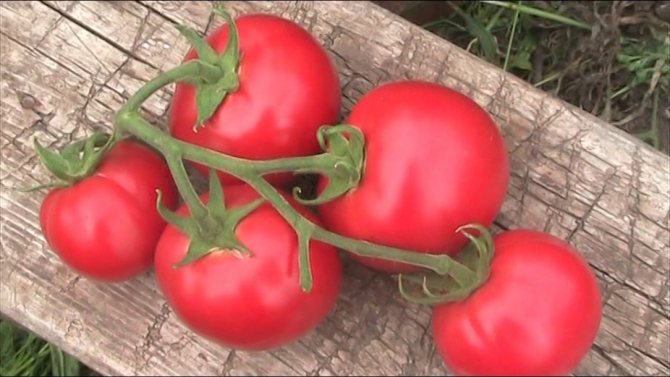

Tomatoes Angel F1 - very presentable fruits, distinguished by excellent taste
The hybrid is characterized by the presence of immunity to fusarium and verticillosis, but it is often affected by apical rot.
Diana F1
Another Russian hybrid, in the State Register of Breeding Achievements of the Russian Federation - since 2010. Suitable for growing in any region where gardening is possible. The crop ripens early, in 90-100 days. The bushes are quite powerful, but they cannot be called densely leafy.
Fruits are spherical or slightly flattened, with slightly protruding ribs at the stalk, medium in size, weighing about 128 g. The skin is bright pink, firm, but not coarse. This leads to very good transportability. The taste is excellent.
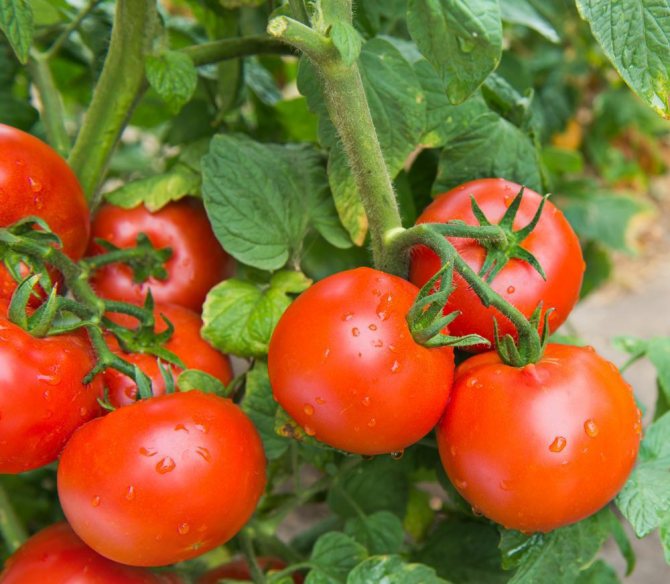

Tomatoes Diana F1, due to their good transportability, are in demand not only by amateur gardeners, but also by professional farmers.
The yield cannot be called a record high - it is 17.9 kg / m².
Icarus F1
Medium ripening hybrid. The crop can be removed 98–110 days after the first germination. The State Register of Breeding Achievements of the Russian Federation is recognized as suitable for cultivation throughout the territory of the Russian Federation. Possesses "innate" immunity to fusarium and tobacco mosaic virus. He suffers from other diseases typical of the culture quite rarely. And also the hybrid firmly tolerates the vagaries of the weather - drought, waterlogging, low temperatures. Not too many stepsons are formed on the bush.
Fruits are noticeably flattened from the sides, similar to plums, with a dense glossy skin. Even fully ripe tomatoes retain a pale light green spot at the base of the stalk. Fruit weight - 130–150 g. The pulp is very fleshy, few seeds.
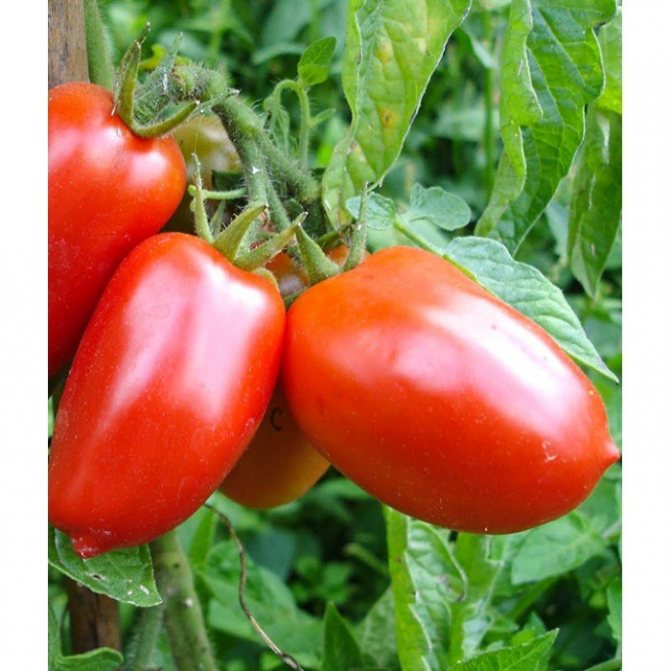

There are not too many stepchildren on the bushes of Icarus F1 tomatoes
The purpose is universal - tomatoes are suitable both for fresh consumption and for home canning, including whole-fruit. The yield for an indeterminate variety is rather low - 10-12 kg / m², but the taste is excellent.
Belfast F1
A very popular worldwide hybrid from the Netherlands. It entered the State Register of Breeding Achievements of the Russian Federation in 2014. In terms of ripening, it is early ripe: the crop is harvested 90–100 days after germination or 55–60 days after planting the seedlings in a permanent place.
The plant is powerful, but the foliage is medium.Its height is limited to 1.5–2 m. The first fruits on the lower clusters ripen rather quickly, which is, in principle, not typical for indeterminate varieties. The bushes are immune to cladosporium, fusarium, verticillosis, tobacco mosaic virus, but all types of nematodes have a special love for the hybrid.
The tomatoes are in the shape of an almost regular ball. The ribs at the stalk are almost invisible. The flesh is not particularly dense, but thanks to the harsh skin, the hybrid has good keeping quality and tolerates transportation well. Fruits rarely crack. The presence of many cameras is characteristic. The average fruit weight is 208 g, some specimens reach 300 g.
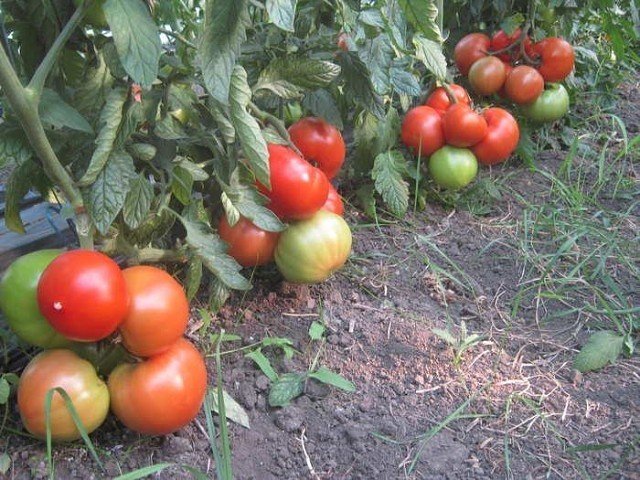

Tomatoes Belfast F1, very popular all over the world, quickly fell in love with Russian gardeners.
The yield is high - 26.2 kg / m². This indicator is little affected by the weather, including low temperature and lack of light.
F1 chart
One of the novelties of the selection, the hybrid was bred in the Netherlands. In terms of ripening, it belongs to early ripening: the fruits are removed after 100-105 days. Productivity - up to 4.5 kg per plant.
Recent Entries
7 super early and delicious potatoes to plant in 2020 6 rare 2020 tomato varieties that will bring you a decent harvest 5 cucumber hybrids I will plant this year without hesitation
The fruits are of the correct spherical shape, the ribs do not always appear, in any case they can be distinguished only at the stalk. One tomato weighs on average 180–230 g. The taste is excellent, with a slight refreshing sourness. An almost complete absence of non-marketable fruits is characteristic, the percentage of rejects is only 0.5%.
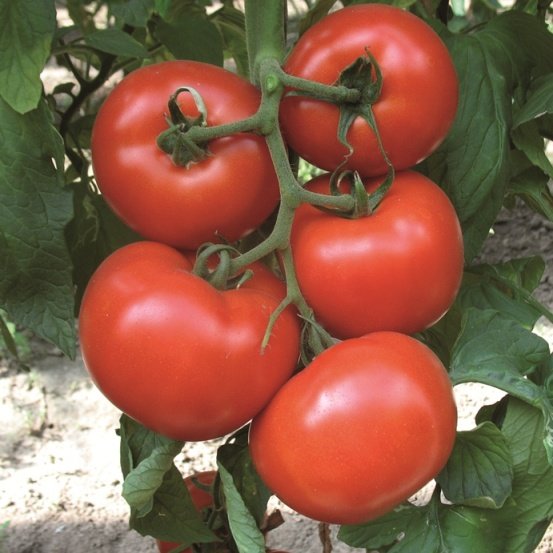

Tomatoes Diagram F1 almost always look very presentable, the percentage of "substandard" fruits is minimal
The bushes can be recognized by their unusually long, light green leaves. The variety cannot be called vigorous; internodes for an indeterminate tomato are unusually short. From their creators, these plants have gained immunity to the tobacco mosaic virus, a fungus that causes brown spot. Relatively rarely, they are affected by verticillosis, fusarium, root rot.
Video: What Tomatoes Look Like F1 Diagram
Pink Paradise F1
A hybrid originally from France, it was included in the State Register of Breeding Achievements of the Russian Federation in 2007. In terms of ripening, it belongs to the mid-season. Fruiting in 110-120 days after germination or 70-75 days after transplanting. You can count on 3.9 kg of fruit per bush. Characterized by the presence of immunity to verticillosis, fusarium, tobacco mosaic virus.
Tomatoes are flattened, slightly ribbed. The skin is glossy, bright pink. The pulp is very dense, high in sugars, the seeds are almost invisible. The average weight of the fruit is 125–140 g, some specimens reach 200 g. The taste is excellent - a variety from the category of gourmet foods. However, almost all pink tomatoes are distinguished by their wonderful taste.
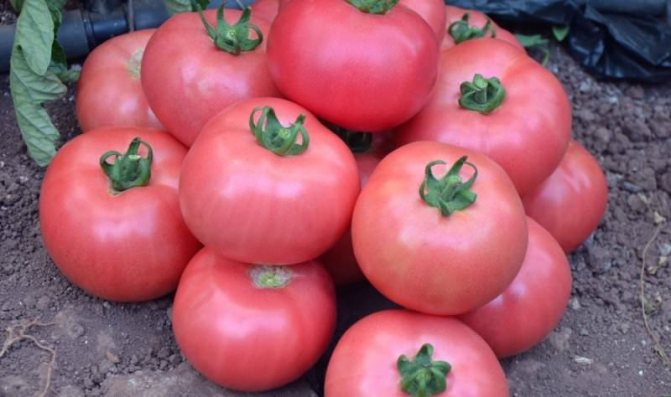

Tomatoes Pink Paradise F1, like all pink tomatoes, have excellent taste.
The height of the bush is about 2 m, it is densely leafy, it is imperative that you regularly pay attention to pruning. Sometimes it is formed into two stems - in this case, the first fruits will have to wait 12-15 days longer, but the yield will increase. The hybrid tolerates a short-term drop in temperature and its drops well. The fruits are characterized by very good transportability and keeping quality, they hardly crack, although the skin is thin, even tender. Suitable for making juice and puree - they turn out to be very thick, with an unusual raspberry hue.
Video: description of the tomato hybrid Pink Paradise F1
Shannon F1
Another popular Dutch hybrid. Russian gardeners met him in 2003.The State Register of Breeding Achievements of the Russian Federation does not give recommendations regarding the growing region, but practice shows that it manifests itself best in warm southern regions. Medium ripening hybrid. The harvest ripens in 98-110 days.
The fruits are rather small, weighing an average of 107 g, some specimens - 160-180 g, in a bunch of 6-8 pieces. The shape is correct, round. The ribs are almost invisible. Taste qualities of ripe tomatoes are excellent. Keeping quality is also very good, even at room temperature the fruits will lie for at least three weeks.
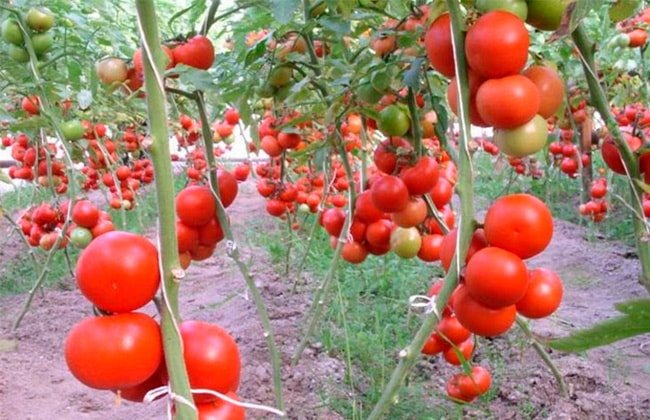

Shannon F1 tomatoes in Russia are best planted in regions with a warm subtropical climate
The variety belongs to the category of indeterminate, but the first fruit cluster is formed low, already above the seventh leaf. The hybrid tolerates heat and drought very well, it is immune to verticillosis, fusarium, brown spot, mosaic virus.
Cherokee
The variety is originally from the USA, at home it is one of the most common. Bred in the 19th century. It is valued for its consistently high yield, excellent taste and the presence of a very good (although not absolute) immunity to diseases typical of the culture. In terms of ripening, it belongs to the medium early, it takes 110-115 days to ripen the crop. You can count on 4 kg per bush.
The height of the bush is usually limited to 1.2–2 m, it is usually formed in 2-3 stems. On each plant, up to 8 fruit clusters ripen, with an average of 10 tomatoes in the shape of a heart. Their color is very unusual: in addition to the usual dull red color, the presence of a subtone is also characteristic - yellowish, purple, violet, chocolate. Sometimes it does not appear over the entire surface of the fruit, but in separate irregularly shaped spots.
The fruits are multi-chambered, the average weight is about 250 g, but depending on the growing conditions, it can vary from 150 g to 500 g. The pulp is very fleshy, juicy, sweetish, with an unusual "smoky" aroma. The skin hardly cracks.
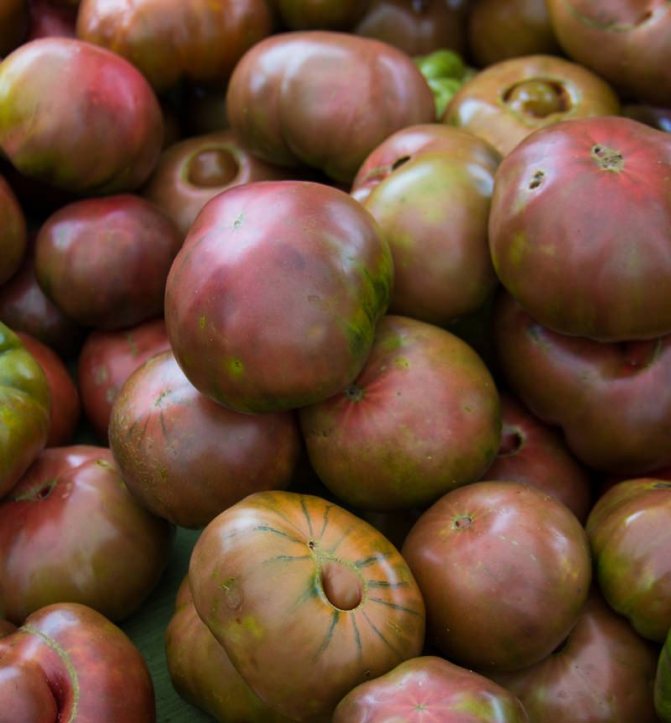

Cherokee tomatoes look very unusual, but this has not scared off several generations of gardeners.
For open ground
When grown outdoors, indeterminate tomatoes will definitely need a support - a trellis or a net. The stems will have to be tied to it along the entire length. In the open field, these varieties can only be planted where the climate for gardening is more or less suitable, that is, in areas with a sufficiently long and warm summer.
Watermelon
Achievement of Russian breeders, in the State Register of Breeding Achievements of the Russian Federation - since 2004. Variety from the category of medium early: the harvest ripens in 107-113 days. The height of the bush without pinching exceeds 2 m. Thick foliage is characteristic. Plants are relatively rarely affected by late blight.
The fruits are flattened, the skin is glossy, smooth. Tomatoes are almost one-dimensional. The shape is rounded, with a pronounced ribbing at the peduncle. The yield is not bad - 4.2–5.6 kg per bush. The average weight of a tomato is 98–104 g, subject to competent agricultural technology, it reaches 550 g. The skin is very thin, the fruits are prone to cracking. The keeping quality and transportability of this variety is low.
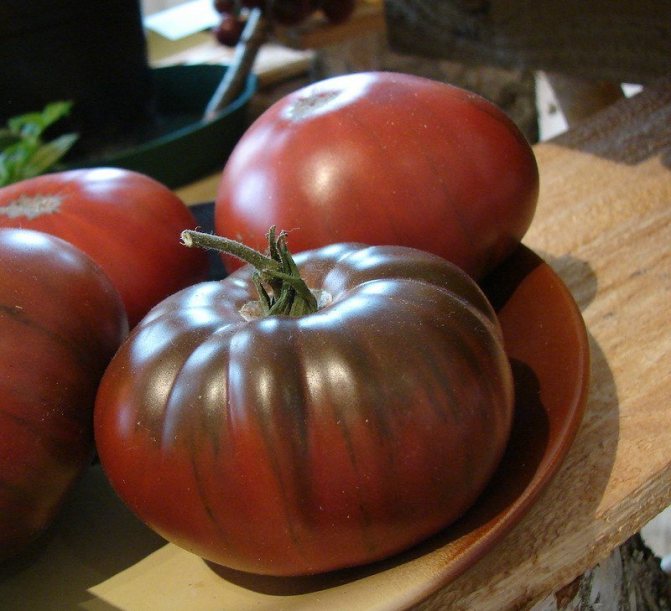

Unripe tomatoes of the Watermelon variety are slightly similar to watermelon
The variety owes its name to the type of fruit in the ripening process. In addition to the usual dark green spot at the stalk on the skin of a salad color, longitudinal blurred stripes of the same shade are also clearly distinguishable. In mature tomatoes, they change color to brick or reddish brown, blotches of the same tone are visible on the cut in the pulp.
Cardinal
The variety has been listed in the State Register of Breeding Achievements of the Russian Federation for 20 years. In terms of ripening, it belongs to the middle late: the crop is harvested 120 days after germination. The variety is valued for its high resistance to late blight and a consistently high yield, which is little influenced by the vagaries of the weather. A tAlso, there is an excellent germination of seeds, including those collected independently.
Fruits are heart-shaped, with ribs clearly visible at the peduncle, in each cluster there are 5–7 pieces. At the top there is a characteristic "nose". The skin is pink-raspberry, matte. The average weight of a tomato is 440 g, the very first fruits gain weight up to 850 g. The pulp is very juicy, sweet, with a slight sourness. The skin is firm but not hard. Productivity - 7.2–8.4 kg per bush and about 16 kg / m².
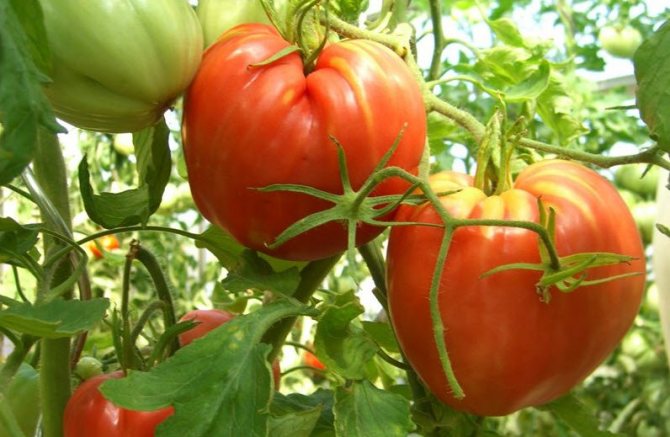

Cardinal tomatoes consistently yield crops no matter how lucky the gardener is with the summer weather.
Belongs to the category of semi-determinant, but differs in unlimited stem growth. The first fruit cluster is formed above the eighth-ninth leaves, the next - with an interval of 1-2 leaves. The bush does not branch very readily, the foliage is weak. It is recommended to stop its growth when it reaches a height of about 2 m.
Video: Cardinal tomatoes
Honey saved
A very popular variety among Russian gardeners. In the State Register of Breeding Achievements of the Russian Federation since 2006. Cultivated without restrictions regarding the growing region. In terms of ripening, it belongs to the mid-season: the first fruits are removed 110-115 days after germination. The variety is appreciated both for its excellent taste and for its unpretentiousness to growing conditions. Shrubs tolerate heat and drought well. Their height, as a rule, is limited at the level of 1.5–1.8 m. The presence of high resistance to phytophthora, gray rot, and the mosaic virus is characteristic.
The shape of the fruit varies from regular and round to kidney-shaped and cordate, the skin is smooth, glossy. Ripe tomatoes are colored in a beautiful golden orange or amber honey color. Sometimes, where the sun fell on them, a pinkish undertone appears. The pulp is sugary, very tender, sweet, with a subtle sourness and a light honey aroma. These fruits are not suitable for canning. There are very few seeds. The average weight of the fetus is 160-220 g.
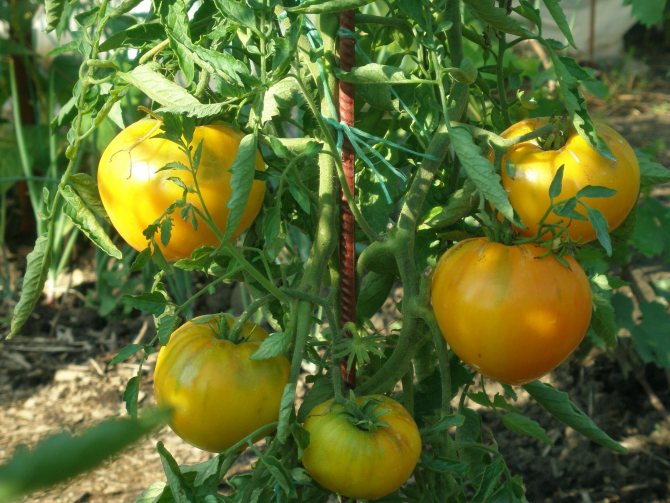

Tomatoes Honey Spas - one of the most popular yellow-fruited varieties in Russia
The yield reaches 5.6 kg per bush, but only when planted in a suitable fertile soil. The fruits do not crack, they have a very good keeping quality and transportability.
Like other yellow tomatoes, this variety is characterized by a high content of beta-carotene and lycopene, causing allergies much less often than “classic” red tomatoes. Such fruits can also be introduced into the children's diet.
Video: review of the popular variety of tomatoes Honey Spas
Japanese crab
Despite the name, the variety was bred in Siberia and specially adapted to the climatic features of this region, although the State Register of Breeding Achievements of the Russian Federation does not give any restrictions on this criterion. In terms of ripening, it belongs to the mid-season. In Siberia, it manages to give a crop even when planted with seeds in open ground. The variety has an "innate" immunity to root and apical rot, the tobacco mosaic virus. It is recommended to form bushes into one or two stems, pinching them when they reach a height of 1.5 m. They have very active step-sonship.
Fruits are noticeably flattened with pronounced ribs. The skin is dense, but not hard, pink-red or crimson, the peduncle retains a dark spot. The pulp is dense, very fleshy, almost without juice, with a pronounced aroma. The fruits are ideal for making ketchup or tomato paste, and retain their attractive appearance in salads for a long time. The average weight of one tomato is 250–350 g, some specimens reach 900 g.
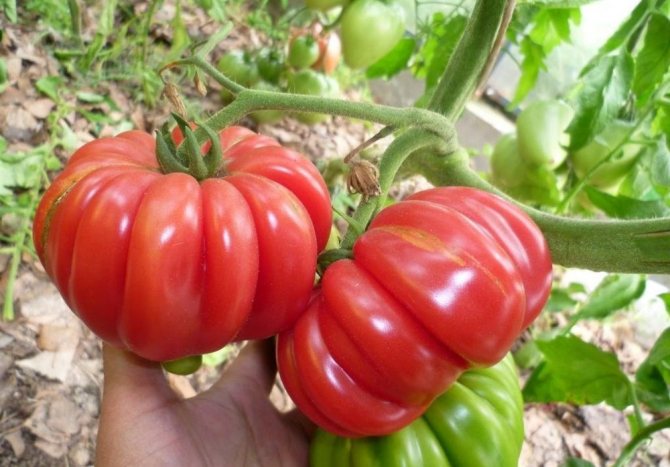

Japanese crab tomatoes are specially zoned for cultivation in Siberia
Productivity - up to 15 kg / m² and about 5-6 kg per bush.
De Barao
A variety bred in Brazil. It entered the Russian State Register of Breeding Achievements in 2000. It can be grown in any regions suitable for gardening.The height of the bush without pinching reaches 4 m. In terms of ripening, it belongs to late ripening. The fruiting period stretches for about 3 months and begins 115–125 days after germination. Accordingly, it is recommended to plant these tomatoes a week and a half earlier than other varieties.
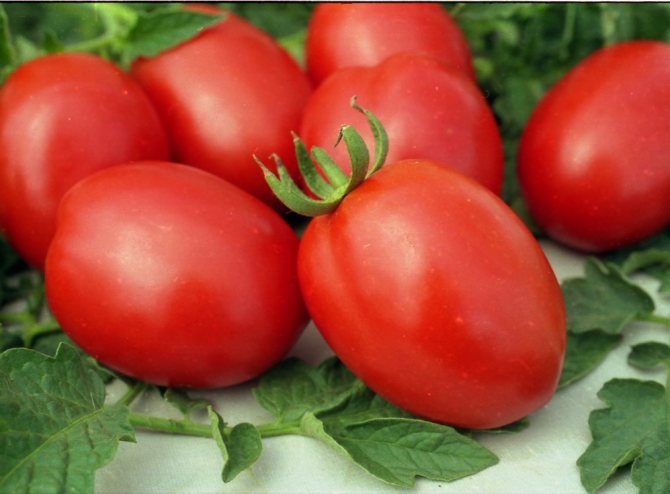

De Barao's "classic" tomato became the "parent" of a whole group of varieties
Plants are immune to late blight at the genetic level; they rarely suffer from other diseases. The yield is very high even when grown outdoors (25 kg / m² or more), and in a greenhouse this figure rises to 40 kg / m². At the same time, experienced gardeners noticed that when planting a number of other varieties of tomatoes, it significantly decreases. The variety tolerates heat and cold well, as well as a lack of light.
A whole series of varieties has been developed on the basis of the "classic" red De Barao tomato. Now in Russia you can find De Barao gold (the most productive - up to 7 kg of fruits per bush), orange (with a high content of carotenoids), pink (less productive, but very tasty), black (with very dense pulp, almost complete absence of seeds and juice) and royal. The latter is a novelty of breeding; it was recently included in the State Register of Breeding Achievements of the Russian Federation. It has improved taste and bears fruit until late autumn.
Fruits are elongated, plum-shaped, with 8-9 fruits on the cluster. The pulp is very firm, fleshy. Weight varies from 30-40 to 100 g. Tomatoes are ideal for home canning. They do not crack in cans, retain their shape and brightness. But you won't be able to squeeze juice out of them.
Video: De Barao tomatoes
Miracle of the earth
Sometimes found under the name "Wonder of the World". Included in the State Register of Breeding Achievements of the Russian Federation in 2006, no restrictions on the region of cultivation are indicated. The ripening time of the crop is average. The yield is not bad - 13.9 kg / m². The height of the bush is 2 m or more. The variety shows a certain "plasticity", successfully adapting to weather conditions that are far from optimal. These tomatoes crack very rarely.
Fruits are round or domed, with weak ribs. The skin is deep raspberry hue. A very low percentage of rejected fruits of a non-marketable type is characteristic - no more than 2%. The average weight of a tomato is 380 g, individual specimens - up to 700 g. On the brush, 5–6 of them are formed, one bush gives 8–10 bunches. The pulp is homogeneous, very tender, literally melting in the mouth, granular on the cut, reminiscent of a watermelon.
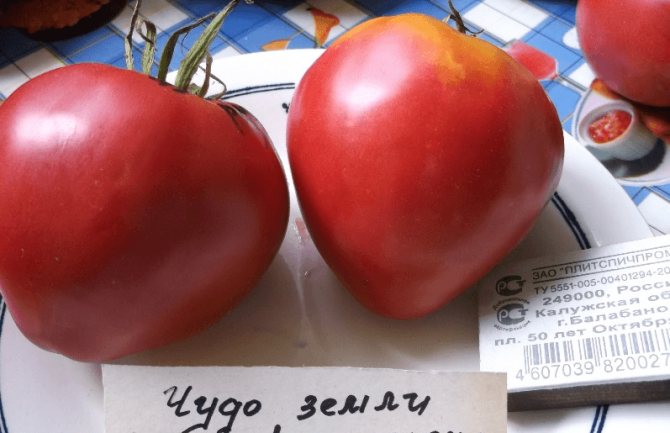

Tomatoes Wonder of the Earth successfully adapt to far from optimal weather conditions
The "record holder" is officially registered - the Miracle of the Earth tomato weighing 1200 g. To grow such a fruit, all the flowers must be removed from the lowest brush, leaving only one. All forming flower buds are cut off, the plant is well watered, and top dressing is applied on time. A single hand must be tied to a support.
The variety is suitable mainly for fresh consumption, the keeping quality is very low. These tomatoes are also good in blanks, suitable for the preparation of tomato paste, juices.
Video: unpretentious tomato variety Miracle of the earth
Typhoon
The variety has been listed in the State Register of Breeding Achievements of the Russian Federation since 1997; its cultivation in the Black Sea region is recommended. However, in other regions it shows itself well, especially in central Russia. The harvest ripens in 99-117 days after germination - this tomato is considered early. Possesses "innate" immunity to cladosporium, Alternaria, tobacco mosaic virus. Does not make high demands on the quality of the soil substrate.
Fruits are regular in shape, almost round or slightly flattened. Average weight - 34–57 g. The first tomatoes on the lowest bunch can reach a weight of 80–100 g. The taste is very good, sweetish. They make excellent juice.The fruits cannot boast of keeping quality and transportability. The pulp is rather loose, so when canning tomatoes often turn into an unappetizing gruel.
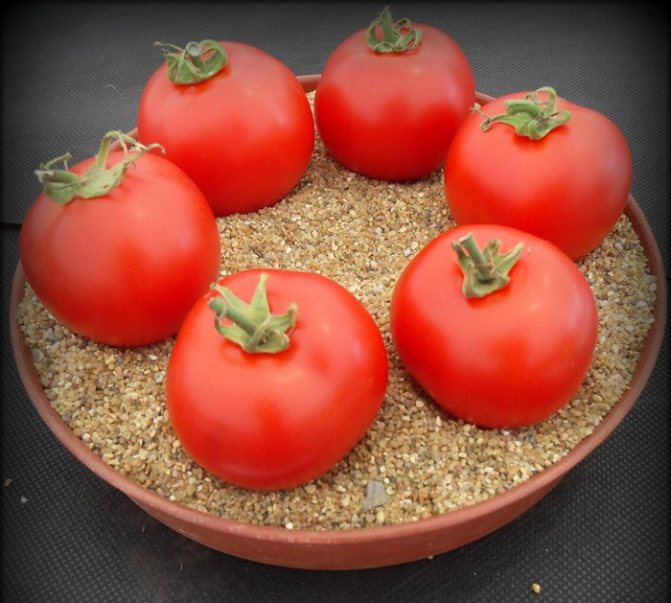

Typhoon tomatoes have regular fruits, almost round or slightly flattened
This is a plant with a very powerful stem, standard. Branching and leafiness are average. When forming in several stems, it is imperative to tie up the side shoots - they are rather fragile. The height of the stem, as a rule, is limited at the level of 1.8–2.2 m. The first fruit cluster is formed low, above the 6–7th leaf. The total yield is 16-18 kg / m² or 4-6 kg per bush.
Advantages and disadvantages
The existing differences will allow you to choose and grow a variety in the most favorable conditions for it, and therefore with the greatest return.
| Indeterminate varieties | Determinant varieties | ||
| pros | Minuses | pros | Minuses |
| 1. Require regular pinching. 2. Obligatory tying of bushes. |
| 1. Fruits once a season for 1-3 weeks. 2. Need additional feeding. |
The best varieties for growing in the country
Gardeners willingly exchange experience, which makes it possible to collect a database of the most popular and recommended varieties of each type.
| 1. Fruits once a season for 1-3 weeks. | ||
| Determinant | Indeterminate | ||
| In the open field | In the greenhouse | In the open field | In the greenhouse |
| Sanya | |||
Honey cream
Big mommy
All standard grades
Cherokee
What types of tomatoes to give preference
It is rational to grow indeterminate varieties of tomatoes in the greenhouse. Bushes, formed into one stem and placed in a checkerboard pattern at a distance of 50 cm from each other, significantly save space in the garden. The distance between the rows must be at least 65 cm.
Determinant tomatoes, planted in open ground or greenhouses, grow into wide bushes and require space. They are placed on the bed with an interval of 80-90 cm.The width between the rows is at least 1 m.
Important! All types of tomatoes need to be tied up when they reach a height of 45 cm.
Reliable support will protect the plant weighed down with fruits from breakage and provide free air exchange around it. In combination with loosening and hilling, proper tying is an excellent prevention of fungal diseases in tomatoes.
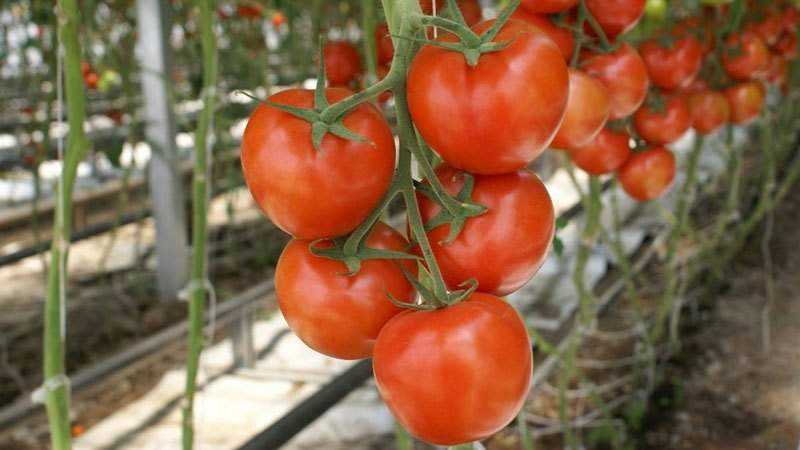

The main thing when growing determinant tomatoes
- Removing stepchildren. Basically, the fruits form the first 3 inflorescences determinant tomatoes. To accelerate ripening, you should remove small stepsons and pinch the shoots;
- When forming bushes, it is necessary to leave side shoots (1-2 pcs.), Located on the main stem, which are then tied up below the first brush;
- Leave up to 4 brushes on the main stem. Form a side shoot with 3 brushes, and then pinch it;
- To continue the growing season, the formation of new shoots should be carried out, while it is important to feed the tomatoes in a timely manner.
The choice of the type depending on the region
Thinking about the choice of a variety, the gardener proceeds not only from his preferences in terms of the early maturity of the culture, the shape, size and taste of the fruits. It is important to correlate the quality characteristics of the variety with the climatic conditions of the growing region. A mistake at this point can have fatal consequences for the future harvest.
Indeterminate tomatoes are renowned for their yield. However, they ripen a month later than the determinant varieties. Taking this feature into account, it is necessary to decide on the placement of seedlings on the site. The warm and moderately humid climate of the southern regions of the country makes it possible to successfully grow such tomatoes both in a greenhouse and in open beds.Beyond the Urals and in central Russia, greenhouse cultivation is preferable.
In northern latitudes, standard varieties are becoming the only alternative to completely abandoning the cultivation of indeterminate tomatoes. Low-growing, with a strong, thick stem, standard tomatoes are resistant to the vagaries of the weather and require minimal maintenance.
Their happy owners are relieved of the tedious tasks of tying and pinching bushes. And the early ripeness of the fruits will delight already at the end of June. They tolerate long-term storage and transportation well.
Most of the determinant varieties are adapted to open and closed types of ground. They take root well in any climatic zones of our country. But in the conditions of a short and cold summer, it is better to grow them in greenhouses.
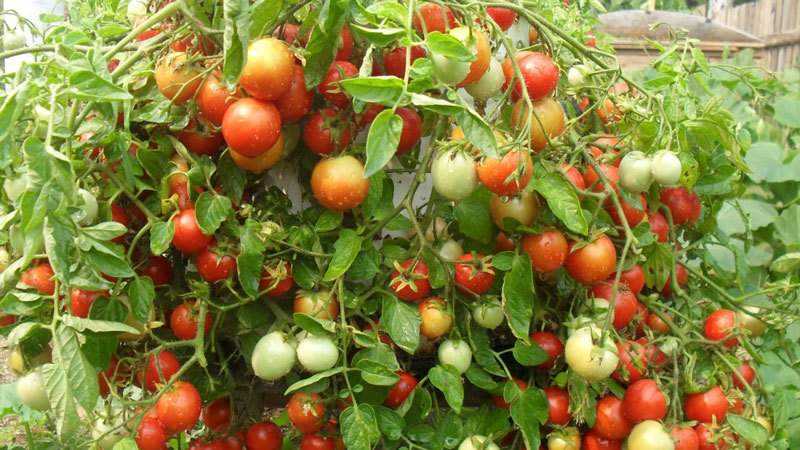

Differences between them
Differences and differences between bushes become noticeable at the stage of growing seedlings... In indeterminate ones, the cotyledonous knee is clearly visible on the 4th day after hatching. Later, when growing a bush, the first ovary in indeterminate ones appears above the 9th leaf, and in the determinant ones, after the 5th leaf plate, the first tomato ovary appears.
Seedlings of determinant varieties, in the presence of 5 leaf plates, begin to form a flower cluster.
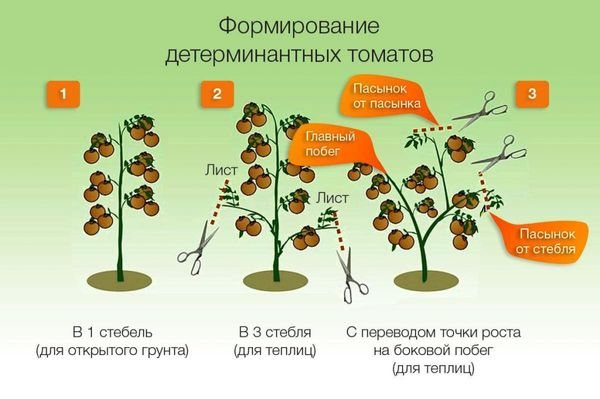

Cultivation scheme of a determinate variety
The formation of a tomato bush also differs significantly - indeterminate form in one stem, and determinant varieties 2-3 stems.
Which varieties are better
It is difficult to say which varieties are better and which ones are worse. Everyone chooses not only for their taste, but also for the region of growth. It is also important where the tomato will grow in the open field or in the greenhouse. Therefore, any type can come in handy when growing a tomato.
On one site different types of tomato can be grown.
The advantages and disadvantages of each of these types
Determinant
pros - early ripening of fruits, high early yields, amicable return of the harvest not stretched out in time.
Minuses - the total yield is lower, since the bush is limited in its growth, a lot of mineral dressings are needed to obtain a large harvest, pinching should be carried out strictly once every 10 days, reduced immunity to diseases that affect tomatoes.
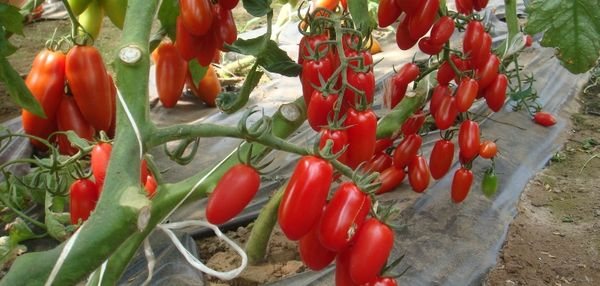

The total yield of determinant varieties is lower than that of indeterminate varieties.
Indeterminate
pros - a large number of tomatoes are harvested in a small area, they are less susceptible to tomato diseases, fruiting is extended for a long period, tomatoes can be removed in September, it is convenient to harvest, since it is harvested while standing.
Minuses - high supports are needed for a tomato bush, cultivation is going well in southern regions with a long summer period, carefully remove all stepsons, forming a bush in only one trunk.
Stamp
pros - they have a low and strong stem that does not require tying, the root system is located on the surface and well absorbs the nutrition that comes to it in the form of irrigation and mineral fertilizers.
Can be planted quite thickly resistant to temperature extremes and drought, the vegetative mass grows well and does not require additional conditions, the absence of stepchildren also simplifies the care of the bushes, the fruits have a long shelf life and tolerate transportation well.
Tips for Beginners
Basic rules for caring for tomatoes:
- We decide on the grade according to the expected result. To get an early harvest, we choose determinant varieties, we want more fruits - we give preference to indeterminate ones.
- We choose a place for planting seedlings, taking into account the characteristics of the variety and the climatic conditions of your region (greenhouse or open ground).
- As they grow, we carefully pinch the indeterminate tomatoes and tie them to a support along the entire length of the stem.
- We feed tomatoes of determinant varieties in a timely manner (during the period of mass flowering, formation of the ovary and ripening of fruits).
- We regularly ventilate the greenhouses, maintaining the optimum temperature and humidity.
- Properly organized watering (under the root), loosening the soil and hilling will strengthen plant health and increase immunity to infectious diseases.
Determinant polycarbonate greenhouse tomatoes
Alsou
- Refers to early maturing;
- Resists tomato diseases well;
- Possesses large fruits that have excellent taste and are well stored;
- Variety garter required.
Spring of the North Hybrid
- Refers to early maturing;
- The tomato fruit is pink in color and medium in size, has a fleshy and juicy pulp.
Pride of Siberia
- Refers to early maturing;
- The bush is up to one and a half meters high;
- Very large fruit size;
- Designed specifically for greenhouses, the exception may be the southern regions, where open ground is also suitable for growing;
- Good immunity to tomato diseases;
- Excellent taste of selected fruits.
Big mommy
- Refers to early-maturing promising fruitful varieties with a vegetation period of 85 days;
- Rarely affected by late blight and powdery mildew;
- The fruit is large, has good taste, does not crack, and has universal application.
Doll Hybrid
- Has practically no competitors when grown in a greenhouse;
- The tomato bush reaches a height of 65 to 75 cm and requires an obligatory dressing;
- The fruit has a sweet, fleshy pulp and a long shelf life.
How to determine the type of tomato
It is good if you grow your own seedlings, and the type of tomato is known. But sometimes this information is unknown. But you need to know it even before planting seedlings in the ground. This can be done at each stage of tomato development.
Seedlings of determinant varieties have a cotyledonous knee no more than 3 cm long. For indeterminate varieties this distance is up to 5 cm. Growing in a poorly lit room can be an exception. In this case, several varieties need to be compared. The one with the longer cotyledonous knee is indeterminate.
You can determine the type of tomatoes by the appearance of the seedlings. In determinant varieties, the first flower cluster is formed no higher than the seventh true leaf. For the indeterminate, it is above the ninth.
And most often this happens with indeterminate varieties. If, when planting, the tomato was immersed to the cotyledonous leaves, it is easier to determine the type. In determinant plants, one or two leaves are located between the brushes, in indeterminate ones - three. The determinant ones have shoots that stopped growing after the ovaries were formed, the indeterminate ones will not. When examining, you need to pay attention to whether this is a pinched shoot. Sometimes it looks like one that has stopped growing.
The height of a tomato does not always indicate its type of formation. There are determinant varieties that grow significantly taller than their counterparts. They are taken out for growing in a greenhouse. There are also low determinant varieties. An example is the hybrid "Volgogradskiy 5/95", which has a strong stem and does not need tying.
What is tomato variety indeterminacy
This characteristic indicates a certain feature of the development of shoots - the ability to grow indefinitely. Such tomatoes do not have the property of stopping at a certain point in growth and directing forces to the ripening of fruits.
Given this feature, care should include mandatory pinching and pinching. It is also necessary to tie the shoots to the support, because they grow up to 2 meters or more.
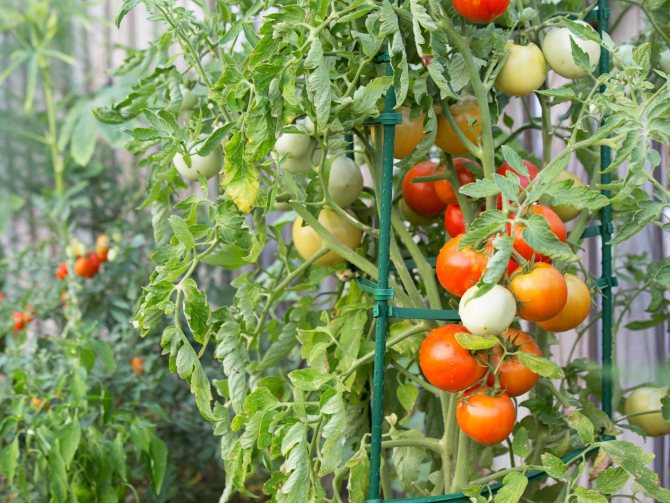

Powerful and productive indeterminate varieties
Attention! The fruits of such tomatoes, as a rule, are collected in clusters of several pieces and, without support, the shoots will break from the weight of ripe bunches.

